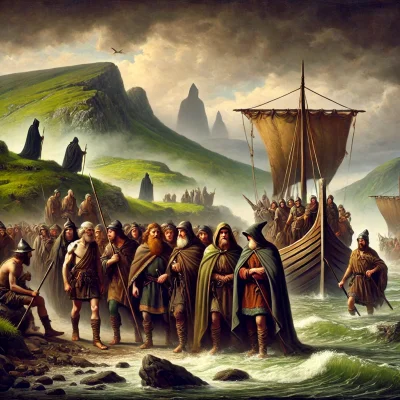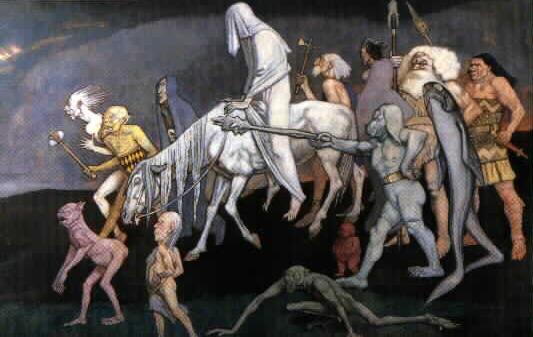The People of Nemed? Ireland’s Forgotten Mythological Settlers
Irish mythology is rich with stories of legendary peoples who settled on the island in ancient times. Among these groups, the People of Nemed (Muintir Nemid) hold a fascinating but often overlooked place. As one of the earliest groups to inhabit Ireland, they endured struggles, victories, and an ultimate downfall that shaped the mythological history of the land. Their battles against the mysterious Fomorians and their legacy in later mythological cycles make them a crucial part of Ireland’s ancient past.
Who Were the People of Nemed?

The People of Nemed were the third group to arrive in Ireland, according to medieval Irish texts like the Lebor Gabála Érenn (The Book of Invasions). Their leader, Nemed, whose name means “sacred” or “privileged,” was said to have led his people from Scythia (a region covering parts of modern-day Eastern Europe and Central Asia). They travelled with 44 ships, but after a perilous journey, only one survived, finally landing on the shores of Ireland.
Like the previous settlers—the Partholónians—the Nemedians were believed to be descendants of Noah (keep in mind these stories were heavily edited by the Church), tracing their lineage back to the great biblical flood. This connection gave them a divine or semi-mythological status, reinforcing the idea that they were destined to play an essential role in Ireland’s history.
Life and Achievements in Ireland
Upon their arrival, the People of Nemed began shaping the land. They cleared forests, built fortresses, and cultivated the soil, making Ireland a habitable and prosperous place. According to legend, they established significant settlements and introduced advancements in farming and construction.
Despite their efforts to build a thriving society, their time in Ireland was plagued with conflict—most notably with the Fomorians, a race of supernatural beings often depicted as sea raiders, giants, or demonic rulers.
The Nemedians vs. The Fomorians

The Fomorians were already present in Ireland when the Nemedians arrived and quickly became their greatest adversaries. The Fomorian rulers Conand and Morc imposed heavy tributes on the Nemedians, demanding payment of two-thirds of their children, crops, and livestock. This oppression led to several attempts by the Nemedians to overthrow their Fomorian overlords.
One of the most significant battles took place at Tory Island, where the Nemedians managed to defeat King Conand. However, their victory was short-lived, as Morc, another Fomorian ruler, retaliated with overwhelming force. The Nemedians found themselves in a losing battle against these supernatural beings, who had an almost otherworldly dominance over the land and sea.
The Fall of the Nemedians
Their struggles against the Fomorians, combined with a devastating plague, ultimately led to the downfall of the People of Nemed. Unable to sustain their population and defend themselves against the Fomorians’ constant attacks, the remaining survivors were forced to flee Ireland. Their dispersal marks an important transition in Irish mythology as different groups emerged from their remnants:
- Some travelled to Britain and became ancestors of later peoples.
- Some went to Greece, where they were enslaved and later returned as the Fir Bolg, another mythological group who would later settle in Ireland.
- Some went to the north, where they evolved into the Tuatha Dé Danann, the powerful divine race that would later defeat the Fomorians.
Legacy of the People of Nemed
Though they vanished from Ireland, the Nemedians left an enduring legacy. Their struggles set the stage for future battles between the Tuatha Dé Danann and the Fomorians, most notably in the First and Second Battles of Mag Tuired. The story of the Nemedians reflects a recurring theme in Irish mythology—the cycle of invasion and displacement, where different groups arrive, struggle, and ultimately fall, only to be replaced by new settlers.
The oppression they faced at the hands of the Fomorians also symbolises the eternal struggle between order and chaos, freedom and tyranny. Their story is one of resilience and perseverance, even in the face of overwhelming odds.
Conclusion
The People of Nemed played a crucial role in the mythological history of Ireland, acting as a bridge between the early settlers and the later, more powerful groups like the Tuatha Dé Danann. Their battles, hardships, and eventual exiles shaped the course of Irish mythology and reinforced the themes of struggle and survival that are so deeply woven into Ireland’s legendary past.
Though they are not as well-known as the Tuatha Dé Danann or the Milesians, the Nemedians are essential to Ireland’s mythological foundation. Their story reminds us that even the greatest struggles contribute to shaping history, leaving behind tales that continue to inspire and intrigue us today.
Recommended Articles:
- Who were the Fomorians
- Who were the Tuatha Dé Danann
- The Arrival of the Milesians in Ireland
- Irish Gods and Goddesses
Further Reading and Exploration:
- Translations of the Táin Bó Cúailnge
- The Story of Ireland by Neil Hegarty
- Early Irish Myths and Sagas by Jeffrey Gantz
- A New History of Ireland: Prehistoric and Early Ireland, edited by Dáibhí Ó Cróinín
- The Knighting of Cú Chulainn
- Birth of Cú Chulainn
